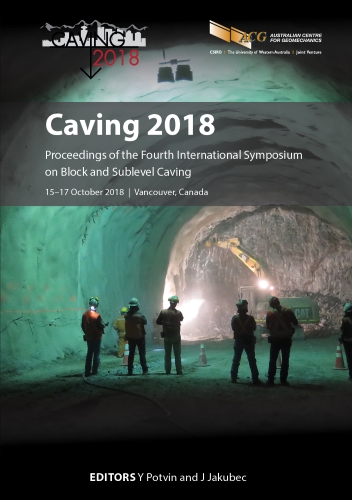Numerical simulations of a centrifuge model of caving

|
Authors: Cumming-Potvin, D; Wesseloo, J; Pierce, ME; Garza-Cruz, T; Bouzeran, L; Jacobsz, SW; Kearsley, E |
DOI https://doi.org/10.36487/ACG_rep/1815_12_Cumming-Potvin
Cite As:
Cumming-Potvin, D, Wesseloo, J, Pierce, ME, Garza-Cruz, T, Bouzeran, L, Jacobsz, SW & Kearsley, E 2018, 'Numerical simulations of a centrifuge model of caving', in Y Potvin & J Jakubec (eds), Caving 2018: Proceedings of the Fourth International Symposium on Block and Sublevel Caving, Australian Centre for Geomechanics, Perth, pp. 191-206, https://doi.org/10.36487/ACG_rep/1815_12_Cumming-Potvin
Abstract:
Validation and calibration of numerical models is vitally important, particularly in the field of cave mining where our ability to monitor the caving rock mass is limited. As part of a project investigating caving mechanics, physical models of caving were tested in a geotechnical centrifuge (Cumming-Potvin et al. 2016b). This paper describes numerical simulations of one of the centrifuge tests. Two approaches were used, so the relative strengths and weaknesses could be compared. The Itasca caving algorithm approach was implemented in FLAC3D and a bonded block model (BBM) approach implemented in 3DEC. The results showed that there was a good match with the physical model in some respects. Both numerical approaches were able to capture the discontinuity in the damage profile seen in the physical model, and the shape of the failed zones also matched the physical model well. The match appeared to be better for the BBM approach. There is some uncertainty as to whether the mechanism of failure seen in the physical model was exhibited in the numerical models. The match between the numerical and physical models could have been improved via further calibration. However, this was outside the scope of this study. Overall, the results show that the numerical approaches used are suitable for practical use in the modelling of caving, particularly if they are suitably calibrated and/or validated using in situ monitoring data.
Keywords: numerical modelling, cave mining, physical modelling, centrifuge, fracture banding
References:
Addis, MA, Barton, N & Bandis, SC 1990, ‘Laboratory studies on the stability of vertical and deviated boreholes’, Proceedings of the 65th Annual Technical Conference and Exhibition of the Society of Petroleum Engineers, Society of Petroleum Engineers, Richardson, pp. 19–30.
Barton, N 1993, ‘Physical and discrete element models of excavation and failure in jointed rock’, Assessment and Prevention of Failure Phenomena in Rock Engineering, A.A. Balkema, Rotterdam, pp. 35–46.
Board, M & Pierce, ME 2009, ‘A review of Rrecent experience in modeling of caving’, Proceedings of the International Workshop on Numerical Modeling for Underground Mine Excavation Design, National Institute for Occupational Safety and Health, Washington, D.C., pp. 19–28.
Crook, T, Willson, S, Yu, JG & Owen, R 2003, ‘Computational modelling of the localized deformation associated with borehole breakout in quasi-brittle materials’, Journal of Petroleum Science and Engineering, vol. 38, pp. 177–186.
Cumming-Potvin, D 2018, An Extended Conceptual Model of Caving Mechanics, PhD thesis, The University of Western Australia, Perth.
Cumming-Potvin, D, Wesseloo, J, Jacobsz, SW & Kearsley, EP 2016a, ‘Fracture banding in caving mines’, The Journal of the Southern African Institute of Mining and Metallurgy, vol. 118, no. 8, pp. 753–761.
Cumming-Potvin, D, Wesseloo, J, Jacobsz, SW & Kearsley, EP 2016b, ‘Results from physical models of block caving’, Proceedings of MassMin2016, The Australasian Institute of Mining and Metallurgy, Melbourne, pp. 329–340.
Ewy, RT & Cook, NGW 1990, ‘Deformation and fracture around cylindrical openings in rock II. Initiation, growth and interaction of fractures’, International Journal of Rock Mechanics and Mining Sciences & Geomechanics Abstracts, vol. 27, no. 5,
pp. 409–427.
Garza-Cruz, TV & Pierce, M 2014, ‘A 3DEC model for heavily veined massive rock masses’, Proceedings of the 48th US Rock Mechanics/Geomechanics Symposium, American Rock Mechanics Association, Alexandria.
Hoek, E 1965, ‘The design of a centrifuge for the simulation of gravitational force fields in mine models’, Journal of the South African Institute of Mining and Metallurgy, vol. 65, no. 9, pp. 455–487.
Itasca Consulting Group 2016a, 3DEC, computer software, Itasca Consulting Group, Minneapolis, https://www.itascacg.com/software/3dec
Itasca Consulting Group 2016b, FLAC3D, computer software, Itasca Consulting Group, Minneapolis, https://www.itascacg.com/software/flac3d
Lisjak, A, Figi, D & Grasselli, G 2014, ‘Fracture development around deep underground excavations: Insights from FDEM modelling’, Journal of Rock Mechanics and Geotechnical Engineering, vol. 6, no. 6, pp. 493–505.
Meier, T, Rybacki, E, Reinicke, A & Dresen, G 2013, ‘Influence of borehole diameter on the formation of borehole breakouts in black shale’, International Journal of Rock Mechanics and Mining Sciences, vol. 62, pp. 74–85.
Stacey, TR 1981, ‘A simple extension strain criterion for fracture of brittle rock’, International Journal of Rock Mechanics and Mining Sciences & Geomechanics Abstracts, vol. 18, no. 6, pp. 469–474.
Wesseloo, J & Stacey, TR 2016, ‘A reconsideration of the extension strain criterion for fracture and failure of Rock’, Rock Mechanics and Rock Engineering, vol. 49, no. 12, pp. 4667–4679.
© Copyright 2025, Australian Centre for Geomechanics (ACG), The University of Western Australia. All rights reserved.
View copyright/legal information
Please direct any queries or error reports to repository-acg@uwa.edu.au
View copyright/legal information
Please direct any queries or error reports to repository-acg@uwa.edu.au
